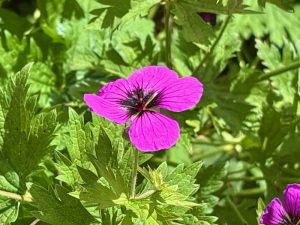Geranium cinereum subsp. subcaulescens: A Hardy, Colorful Cranesbill for Rock Gardens and Beyond
Geranium cinereum subsp. subcaulescens, commonly known as Ashy Cranesbill or Black-eyed Magenta cranesbill, is a compact, low-growing perennial that brings vibrant color and texture to garden beds, borders, and rockeries. Belonging to the Geraniaceae family, this European and Turkish native thrives in well-drained soils and adds weeks of magenta-hued charm to the spring and early summer garden. With its mounded habit, finely textured leaves, and eye-catching black-centered blooms, this hardy geranium is an indispensable choice for gardeners seeking a reliable, fuss-free groundcover with ornamental appeal.
Distinctive Appearance of Geranium cinereum subsp. subcaulescens
The foliage of Geranium cinereum subsp. subcaulescens is one of its standout features. The plant forms a neat, low mound of deeply lobed, grey-green leaves, each with five to seven wedge-shaped sections. In cooler weather, these leaves often turn reddish, adding another layer of seasonal interest. The soft, velvety texture of the foliage creates a striking contrast against its bright flowers.
Flowering begins in mid-spring and continues for six to seven weeks, often with a smaller reblooming period in early fall. The blooms are about 2.5 cm (1 inch) across, displaying deep magenta petals with striking black centers. These blossoms appear in profusion, giving the plant a bold splash of color. As the name “black-eyed magenta cranesbill” suggests, the dark eye of the flower intensifies its vibrancy.
In terms of size, this hardy perennial remains modest—typically growing 15–20 cm (6–8 inches) tall with a spread of 20–30 cm (8–12 inches). This compact habit makes it ideal for edging pathways, filling crevices in rock gardens, or adding bursts of color to container plantings.
Seasonal Performance and Growth Habit
This subspecies thrives in temperate climates, where its foliage remains attractive throughout the growing season. It performs particularly well in regions with cool summers, maintaining healthy, vibrant leaves and reliable flower production. Gardeners in hot and humid areas may find that it struggles without sufficient afternoon shade and consistent moisture.
Unlike some hardy geraniums that can become leggy, Geranium cinereum subsp. subcaulescens stays neatly mounded. This makes it a versatile choice for both formal and informal gardens.
How to Grow Geranium cinereum subsp. subcaulescens
Light
Plant Geranium cinereum subsp. subcaulescens in full sun for the most abundant flowering. In hotter climates, it benefits from light afternoon shade, which helps prevent stress and prolongs bloom time.
Soil
This perennial thrives in well-drained soil, preferring sandy or loamy conditions. It tolerates a range of soil types, from poor rocky substrates to richer garden loam, provided drainage is excellent. In heavy clay soils, amend with grit, compost, or sharp sand to improve texture.
Watering
During its first growing season, keep the soil evenly moist to establish a strong root system. Once mature, this plant tolerates brief dry periods but performs best with consistent, moderate watering. Overwatering should be avoided, as waterlogged soils can lead to root rot.
Fertilizing
Feed Geranium cinereum subsp. subcaulescens lightly in early spring with a balanced, slow-release fertilizer or a top-dressing of compost. This will encourage healthy growth and an extended bloom period. Avoid over-fertilizing, as this can lead to excess foliage at the expense of flowers.
Pruning and Deadheading
Deadhead regularly by removing spent blooms to encourage new flowers and maintain a tidy appearance. After its primary flowering flush in early summer, shear the entire plant back to about 5–7 cm (2–3 inches) above ground. This rejuvenates the foliage and can trigger a secondary flush of blooms later in the season.
Propagationof Geranium cinereum subsp. subcaulescens
This geranium propagates easily through several methods:
- Division: Divide clumps in early spring or fall. This not only produces new plants but also rejuvenates older ones.
- Cuttings: Take basal cuttings in late spring or root cuttings in autumn for reliable propagation.
- Seed: Sow seeds in spring. Keep in mind that named cultivars may not come true to type when grown from seed.
Pests and Diseases
Geranium cinereum subsp. subcaulescens is generally disease-resistant and rarely troubled by pests. However, aphids, spider mites, and leaf-eating caterpillars can occasionally appear. Inspect plants regularly and treat infestations promptly with insecticidal soap or other organic controls. In humid climates, watch for powdery mildew and botrytis; good air circulation and avoiding overhead watering can prevent these issues.
Winter Hardiness and Overwintering
This hardy cranesbill withstands temperatures down to USDA Zone 5 (–28°C / –20°F). In colder regions, apply a light layer of mulch in late fall to protect the root crown. In containers, bring plants into a sheltered spot or an unheated greenhouse during winter to prevent freeze damage.
Landscaping Uses
Thanks to its compact form and extended bloom time, Geranium cinereum subsp. subcaulescens fits beautifully into multiple garden settings:
- Rock gardens: Its low, mounded habit and drought tolerance make it perfect for crevices and raised beds.
- Borders and edging: Plant along the front of mixed borders or pathways for a colorful edging.
- Groundcover: Use en masse as a low-maintenance, spreading mat under roses or taller perennials.
- Containers: Ideal for patio pots, where its cascading habit softens container edges.
This plant also attracts pollinators such as bees and butterflies, making it a valuable addition to wildlife-friendly gardens. Additionally, it resists browsing by deer and rabbits, ensuring its performance in challenging landscapes.
Behind the Name
The genus name Geranium comes from the Greek word “geranos,” meaning crane, referring to the plant’s beak-like seed pods. The subspecies epithet “subcaulescens” translates to “with a small stem,” aptly describing its low, mounded growth form.
Why Choose
Geranium cinereum subsp. subcaulescens for Your Garden?
This hardy geranium brings together resilience, color, and low-maintenance care in one compact package. Its bright magenta flowers make a bold statement against its ashy green foliage, while its ability to tolerate drought, poor soils, and deer browsing makes it a practical choice for a variety of garden styles. Whether planted in rock gardens, along paths, or in patio containers, Geranium cinereum subsp. subcaulescens delivers reliable beauty from spring through early summer—and sometimes beyond.



